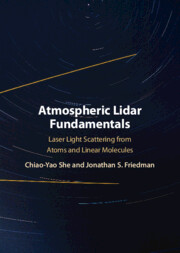Book contents
- Atmospheric Lidar Fundamentals
- Atmospheric Lidar Fundamentals
- Copyright page
- Dedication
- Contents
- Foreword
- Preface
- 1 Introduction
- 2 Classical Light Scattering Theory
- 3 Semiclassical Treatment of Light Absorption and Scattering from Atoms
- 4 Rayleigh and Raman Scattering from Linear Molecules
- 5 Introduction to Lidar Remote Sensing and the Lidar Equation
- 6 Common (Broadband) Lidar Types and Associated Applications
- 7 Lidars for Profiling Aerosol Optical Properties, Atmospheric Temperature and Wind
- 8 Transmitting and Receiving Optics
- Book part
- Index
- References
1 - Introduction
Published online by Cambridge University Press: 24 February 2022
- Atmospheric Lidar Fundamentals
- Atmospheric Lidar Fundamentals
- Copyright page
- Dedication
- Contents
- Foreword
- Preface
- 1 Introduction
- 2 Classical Light Scattering Theory
- 3 Semiclassical Treatment of Light Absorption and Scattering from Atoms
- 4 Rayleigh and Raman Scattering from Linear Molecules
- 5 Introduction to Lidar Remote Sensing and the Lidar Equation
- 6 Common (Broadband) Lidar Types and Associated Applications
- 7 Lidars for Profiling Aerosol Optical Properties, Atmospheric Temperature and Wind
- 8 Transmitting and Receiving Optics
- Book part
- Index
- References
Summary
Chapter 1 is an introduction, reviewing the current state of instructional texts on atmospheric lidar. We point to the lack of a treatment of light scattering as employed by lidar from fundamental physics, the motivation for writing this book. We then summarize the scattering processes, Rayleigh, Raman, Mie, and fluorescence, that enable us to probe the state of the atmosphere with lidar. We include a description of the structure and content of the chapters that follow.
Keywords
- Type
- Chapter
- Information
- Atmospheric Lidar FundamentalsLaser Light Scattering from Atoms and Linear Molecules, pp. 1 - 6Publisher: Cambridge University PressPrint publication year: 2022

